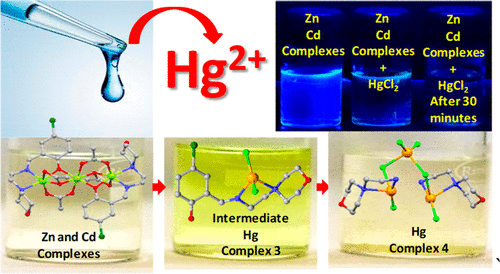当前位置:
X-MOL 学术
›
Inorg. Chem.
›
论文详情
Our official English website, www.x-mol.net, welcomes your
feedback! (Note: you will need to create a separate account there.)
A Chemodosimetric Approach for Fluorimetric Detection of Hg2+ Ions by Trinuclear Zn(II)/Cd(II) Schiff Base Complex: First Case of Intermediate Trapping in a Chemodosimetric Approach.
Inorganic Chemistry ( IF 4.3 ) Pub Date : 2020-06-23 , DOI: 10.1021/acs.inorgchem.0c00857 Abani Sarkar 1 , Aratrika Chakraborty 1 , Tonmoy Chakraborty 1 , Suranjana Purkait 1 , Debabrata Samanta 2 , Suvendu Maity 3 , Debasis Das 1
Inorganic Chemistry ( IF 4.3 ) Pub Date : 2020-06-23 , DOI: 10.1021/acs.inorgchem.0c00857 Abani Sarkar 1 , Aratrika Chakraborty 1 , Tonmoy Chakraborty 1 , Suranjana Purkait 1 , Debabrata Samanta 2 , Suvendu Maity 3 , Debasis Das 1
Affiliation

|
The present work discloses the application of two fluorescent zinc and cadmium complexes (1 and 2) for sensing of Hg(II) ions through a chemodosimetric approach. The ligand under consideration in this work is a N2O donor Schiff base ligand (E)-4-bromo-2-(((2-morpholinoethyl)imino)methyl)phenol (HL), which has been harnessed to generate complexes [Zn3L2(OAc)4] (1) and [Cd3L2(OAc)4] (2). X-ray single crystal diffraction studies unveil the trinuclear skeleton of complexes 1 and 2. Both complexes have been found to be highly fluorescent in nature. However, the quantum efficiency of Zn(II) complex (1) dominates over the Cd(II) analogue (2). The absorption and emission spectroscopic properties of the complexes have been investigated by density functional theory. Complexes 1 and 2 can detect Hg2+ ions selectively by fluorescence quenching, and it is noteworthy to mention that the mechanism of sensing is unique as well as interesting. In the presence of Hg2+ ions, complexes 1 and 2 are transformed to mononuclear mercuric intermediate complex (3) and finally to a trinuclear mercuric complex (4) by hydrolysis. We have successfully trapped the intermediate complex 3, and we characterized it with the aid of X-ray crystallography. Transformation of complexes 1 and 2 to intermediate complex 3 and finally to 4 has been established by UV–vis spectroscopy, fluorescence spectroscopy, ESI-MS spectroscopy, 1H NMR spectroscopy, and X-ray crystallography. The spontaneity of the above conversion is well supported by thermodynamic aspects as reflected from density functional theoretical calculations.
中文翻译:

三核Zn(II)/ Cd(II)Schiff碱络合物荧光检测Hg2 +离子的化学计量方法:化学计量方法中中间捕获的第一种情况。
本工作公开了两种荧光锌和镉络合物(1和2)通过化学计量学方法感测Hg(II)离子的应用。在这项工作中考虑的配体是N 2 O供体席夫碱配体(E)-4-溴-2-((((2-吗啉代乙基)亚氨基)甲基)酚(HL),已被利用来生成络合物[ Zn 3 L 2(OAc)4 ](1)和[Cd 3 L 2(OAc)4 ](2)。X射线单晶衍射研究揭示了配合物1和配合物的三核骨架2。已经发现两种复合物在性质上都是高度荧光的。然而,Zn(II)配合物(1)的量子效率比Cd(II)类似物(2)更为重要。通过密度泛函理论研究了配合物的吸收和发射光谱性质。配合物1和2可以通过荧光猝灭选择性地检测Hg 2+离子,值得注意的是,传感机制既独特又有趣。在存在Hg 2+离子的情况下,复合物1和2被转化为单核汞中间物复合物(3),最后通过水解生成三核汞络合物(4)。我们已经成功地捕获了中间体配合物3,并借助X射线晶体学对其进行了表征。通过紫外可见光谱,荧光光谱,ESI-MS光谱,1 H NMR光谱和X射线晶体学已经确定了复合物1和2向中间复合物3以及最终向4的转化。从密度泛函理论计算中可以看出,热力学方面很好地支持了上述转换的自发性。
更新日期:2020-07-06
中文翻译:

三核Zn(II)/ Cd(II)Schiff碱络合物荧光检测Hg2 +离子的化学计量方法:化学计量方法中中间捕获的第一种情况。
本工作公开了两种荧光锌和镉络合物(1和2)通过化学计量学方法感测Hg(II)离子的应用。在这项工作中考虑的配体是N 2 O供体席夫碱配体(E)-4-溴-2-((((2-吗啉代乙基)亚氨基)甲基)酚(HL),已被利用来生成络合物[ Zn 3 L 2(OAc)4 ](1)和[Cd 3 L 2(OAc)4 ](2)。X射线单晶衍射研究揭示了配合物1和配合物的三核骨架2。已经发现两种复合物在性质上都是高度荧光的。然而,Zn(II)配合物(1)的量子效率比Cd(II)类似物(2)更为重要。通过密度泛函理论研究了配合物的吸收和发射光谱性质。配合物1和2可以通过荧光猝灭选择性地检测Hg 2+离子,值得注意的是,传感机制既独特又有趣。在存在Hg 2+离子的情况下,复合物1和2被转化为单核汞中间物复合物(3),最后通过水解生成三核汞络合物(4)。我们已经成功地捕获了中间体配合物3,并借助X射线晶体学对其进行了表征。通过紫外可见光谱,荧光光谱,ESI-MS光谱,1 H NMR光谱和X射线晶体学已经确定了复合物1和2向中间复合物3以及最终向4的转化。从密度泛函理论计算中可以看出,热力学方面很好地支持了上述转换的自发性。











































 京公网安备 11010802027423号
京公网安备 11010802027423号